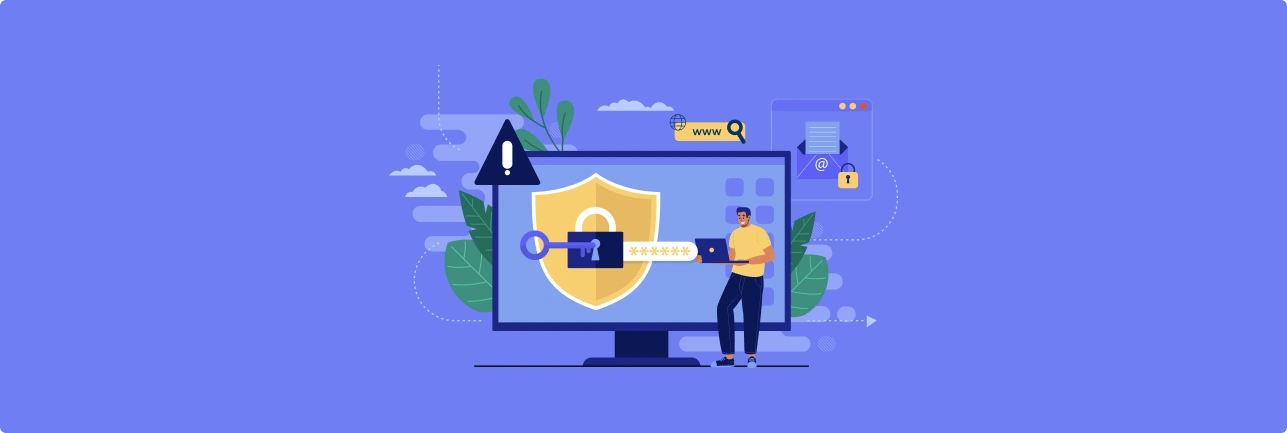Is Your SaaS App Secure? Vital Tips for Cyber Safety
Posted By - Pony

Posted On - November 30, 2023

Businesses are increasingly adopting cloud-based solutions to streamline operations. However, the escalating threat of insider risks and cybercrime activities underscores the critical importance of securing valuable data in the cloud.
This blog will delve into essential practices to fortify the security of your SaaS applications, empowering you to leverage their convenience and scalability with confidence.
The Shared Responsibility Model
Before delving into the tips for enhancing SaaS app security, it’s crucial to grasp the shared responsibility model. The security responsibilities for SaaS applications are distributed between the provider and the customer. This collaborative approach necessitates a meticulous consideration of security measures at both ends to ensure a seamless and secure transition to a third-party SaaS provider.
Research and Due Diligence
Before committing to a SaaS provider, conducting comprehensive research is imperative. Leveraging your network of trusted contacts to gather insights into a particular cloud service provider’s reputation and security measures is recommended. As part of your due diligence process, inquire about the provider’s information security management system (ISMS), data encryption protocols, data backup procedures, and the use of administrative segregation of duties.
Choosing a Reputable SaaS Provider
Selecting a well-established and trusted SaaS provider significantly reduces the risk of security breaches. Look for providers with strong data protection records and certifications, indicating their commitment to adhering to industry standards and implementing robust security measures.
5 Essential SaaS Security Practices
1. Implement Strong Access Controls
Effective access controls are crucial for both the SaaS provider and the customer. Providers should employ measures like segregation of duties, just-in-time access control, privilege identity management, and privilege access management. As a client engaging with a SaaS App Development Company, it is imperative to ensure that robust internal access controls are in place. This involves meticulous management of user permissions, enforcement of strong password policies, and regular review of access control lists to mitigate potential security risks. Consider implementing multi-factor authentication and single sign-on solutions for added security.
2. Regularly Monitor and Audit SaaS Access
Monitoring and auditing your SaaS environment is vital for detecting suspicious activities and potential security breaches. Implementing a security information and event management (SIEM) solution to centralize and analyze security event data is recommended. Additionally, check whether the SaaS provider offers a system for monitoring and logging user activity within their environment to block unauthorized SaaS applications and prevent rogue activity.
3. Data Encryption and Backups
Data encryption is a critical aspect of SaaS security. Emphasize the importance of robust encryption protocols to protect data in transit and at rest. Inquire about your SaaS provider’s data backup procedures and ensure data is backed up to a secure location. Regular backups are essential for quick recovery and minimizing the impact of a potential breach.
4. Updates and Patching
SaaS providers regularly release updates and patches to address security vulnerabilities. Ensure your provider is proactive in applying updates to minimize the risk of threats.
Winding Up
While SaaS applications offer numerous benefits, prioritizing security is non-negotiable. Following these vital tips for cyber safety allows businesses to confidently embrace the convenience and scalability of SaaS applications without compromising on security. In conclusion, by adopting these best practices, organizations can navigate the SaaS landscape with enhanced resilience against potential cyber threats.
Now, learn about the FAQ’s:
FAQ 1: What is the shared responsibility model in the context of SaaS security?
Answer: The shared responsibility model outlines that security responsibilities for SaaS applications are distributed between the provider and the customer. While the provider ensures the security of the underlying infrastructure, customers are responsible for securing their data, managing user access, and implementing additional security measures within the application.
FAQ 2: How can businesses ensure the security credentials of a SaaS provider before committing to their services?
Answer: Before committing to a SaaS provider, businesses should conduct thorough research and due diligence. This involves leveraging trusted contacts to gather insights into the provider’s reputation, examining their information security management system (ISMS), understanding data encryption protocols, assessing data backup procedures, and verifying the implementation of administrative segregation of duties.
FAQ 3: What are the key access control measures that should be implemented by both SaaS providers and customers?
Answer: Both SaaS providers and customers should implement effective access controls. Providers can use segregation of duties, just-in-time access control, privilege identity management, and privilege access management. Customers should manage user permissions, enforce strong password policies, regularly review access control lists, and consider additional measures like multi-factor authentication and single sign-on solutions.
FAQ 4: Why is monitoring and auditing SaaS access crucial for security?
Answer: Monitoring and auditing SaaS access are essential for detecting suspicious activities and potential security breaches. Implementing a security information and event management (SIEM) solution helps centralize and analyze security event data. Additionally, monitoring user activity within the SaaS environment can help block unauthorized applications and prevent rogue activities.
FAQ 5: How does data encryption contribute to SaaS security, and what should be considered regarding data backups?
Answer: Data encryption is critical for SaaS security, protecting data both in transit and at rest. Businesses should emphasize the importance of robust encryption protocols. Regarding data backups, it’s crucial to inquire about the SaaS provider’s backup procedures and ensure that data is regularly backed up to a secure location. Regular backups facilitate quick recovery and minimize the impact of potential breaches.












